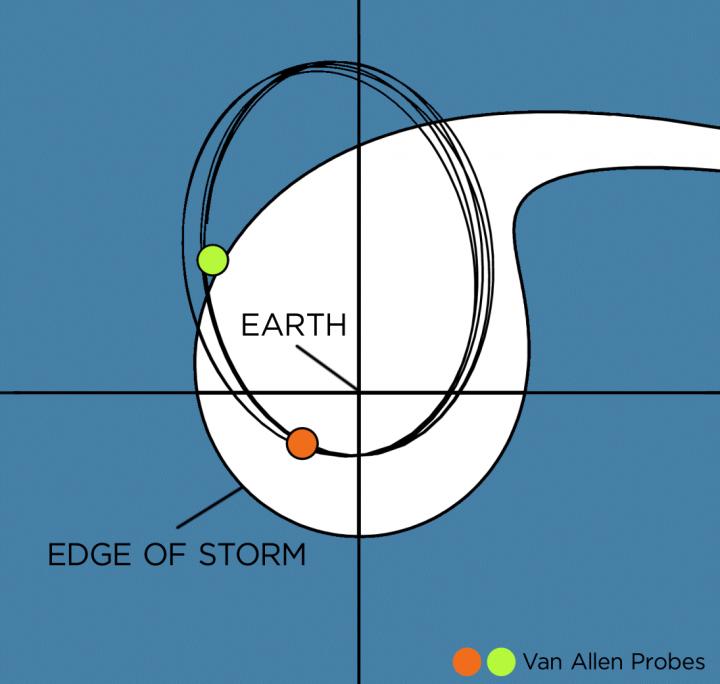NASA spacecraft investigate clues in radiation belts

The twin Van Allen Probes orbit one behind the other, investigating clues in a way a single spacecraft never could. In this model, the trailing spacecraft saw an increase in injected oxygen particles (blue), which was unobserved by the first. The increase in particles was due to a geomagnetic storm front that moved across the path of the orbit after the first spacecraft passed. Credit: NASA's Goddard Space Flight Center/Mike Henderson/Joy Ng, Producer
NASA's Van Allen Probes act as space detectives, to help study the complex particle interactions that occur in these rings, known as the Van Allen radiation belts.
Recently, the spacecraft were in just the right place, at just the right time, to catch an event caused by the fallout of a geomagnetic storm as it happened. They spotted a sudden rise in particles zooming in from the far side of the planet, improving our understanding of how particles travel in near-Earth space.
The two twin Van Allen Probe spacecraft orbit one behind the other, investigating clues in a way a single spacecraft never could.
On one typical day, as the first instrument traveled around Earth, it spotted nothing unusual, but the second, following just an hour later, observed an increase in oxygen particles speeding around Earth's dayside — the side nearest the sun. Where did these particles come from? How had they become so energized?
Scientists scoured the clues to figure out what was happening. With the help of computer models, they deduced that the particles had originated on the night side of Earth before being energized and accelerated through interactions with Earth's magnetic field.
As the particles journeyed around Earth, the lighter hydrogen particles were lost in collisions with the atmosphere, leaving an oxygen-rich plasma. The findings were presented in a recent paper in Geophysical Review Letters.
The unique double observations of the Van Allen Probes help untangle the complex workings of Earth's magnetic environment. Such information has provided the very first view of these harsh belts from the inside — and it helps us better protect satellites and astronauts traveling through the region.
Media Contact
All latest news from the category: Physics and Astronomy
This area deals with the fundamental laws and building blocks of nature and how they interact, the properties and the behavior of matter, and research into space and time and their structures.
innovations-report provides in-depth reports and articles on subjects such as astrophysics, laser technologies, nuclear, quantum, particle and solid-state physics, nanotechnologies, planetary research and findings (Mars, Venus) and developments related to the Hubble Telescope.
Newest articles

Trotting robots reveal emergence of animal gait transitions
A four-legged robot trained with machine learning by EPFL researchers has learned to avoid falls by spontaneously switching between walking, trotting, and pronking – a milestone for roboticists as well…

Innovation promises to prevent power pole-top fires
Engineers in Australia have found a new way to make power-pole insulators resistant to fire and electrical sparking, promising to prevent dangerous pole-top fires and reduce blackouts. Pole-top fires pose…

Possible alternative to antibiotics produced by bacteria
Antibacterial substance from staphylococci discovered with new mechanism of action against natural competitors. Many bacteria produce substances to gain an advantage over competitors in their highly competitive natural environment. Researchers…





















